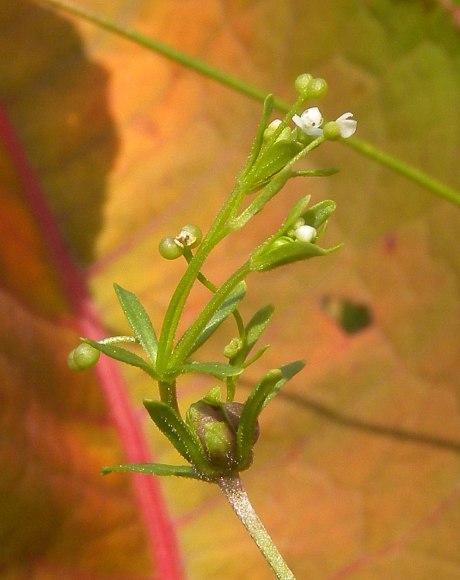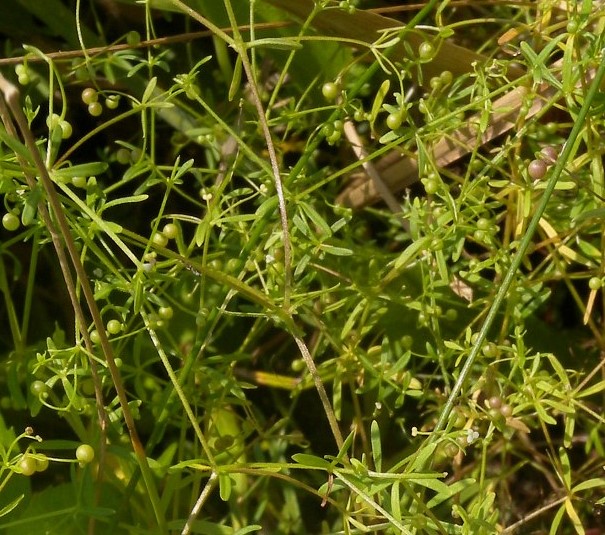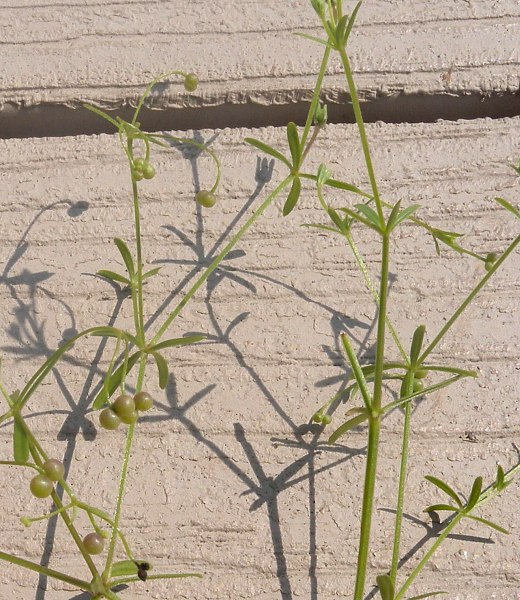
Each flower is about 1.5–2 mm. across, consisting of a white corolla with 3 lobes, 3 stamens, 2 styles that are joined together at the base, and 2 spheroid light green ovaries that are connected together. The lobes of the corolla are oval-ovate in shape. The pedicels of the flowers are usually longer than the corresponding leaves. These pedicels are light green to light purplish green and usually more or less curved; they have short stiff hairs that can cling to adjacent vegetation or objects. The pedicels become even longer as the ovaries mature. The blooming period occurs from mid-summer to late summer for about 1½ months. Only a few flowers are in bloom at the same time. Afterwards, the maturing paired ovaries expand in size, changing color from light green (or light purple) to brown (or black) at maturity. These ovaries are hairless and single-seeded; they eventually split apart. The small seeds are spheroid in shape and partially hollow inside; they are capable of floating on water and being distributed by it. The root system is shallow and fibrous.
Cultivation: The preference is full or partial sun, shallow water or wet conditions, a substrate containing some sand or organic material, and a relatively cool climate.

Range & Habitat: Small Bedstraw (Galium trifidum) is uncommon in Illinois, occurring in the NE section of the state, and a central section of the state along or near the Illinois River (see Distribution Map). Illinois lies along the southern range-limit of this species. It is more widely distributed in North America further to the north and it also occurs in Eurasia. Habitats include edges of sphagnum bogs, cattail marshes, low sandy areas along rivers, and northern swamps. In Illinois, Small Bedstraw is found in high quality wetlands in natural areas.
Faunal Associations: Various insects feed on foliage or sap of bedstraws (Galium spp.). These insect feeders include the larvae of a leaf-mining fly (Galiomyza galiivora), larvae of the Bedstraw Midge (Dasineura americana), larvae of an introduced sawfly (Halidamia affinis), and larvae of the Galium Sphinx (Hyles gallii); see Spencer & Steyskal, 1986; Felt, 1917; Smith, 2006; Wagner, 2005). Other insects that have been observed to feed on bedstraws include aphids, the larvae of Geometer moths, plant bugs (Miridae), stinkbugs (Pentatomidae), and ebony bugs (Thyreocoridae). The nectar and pollen of the flowers of these plants attract primarily small bees and flies (Robertson, 1929). Bedstraws that inhabit wetlands are a minor source of food to Muskrats (Hamerstrom & Blake, 1939).

Photographic Location: A cattail marsh near Volo Bog in Lake County, Illinois.
Comments: This bedstraw is quite small in size and rather inconspicuous. It can be distinguished from other bedstraw species (Galium spp.) primarily by the 3-lobed corollas of its flowers, the whorls of 4 leaves along its stems, the long curved pedicels of its flowers or fruits, and its strong preference for wetland habitats. The only other bedstraw species that produces 3-lobed flowers in Illinois, Stiff Bedstraw (Galium tinctorium), is a little larger in size overall. Unlike Small Bedstraw (Galium trifidum), Stiff Bedstraw sometimes has whorls of 5-6 leaves along its stems and sometimes it also produces 4-lobed flowers (even on the same plant). The pedicels of Stiff Bedstraw with maturing fruits are shorter in length and more straight than those of Small Bedstraw, and they are hairless. Another similar bedstraw, Wild Madder (Galium obtusum), is also slightly larger in size than Small Bedstraw. Wild Madder always produces flowers with 4-lobed corollas; it has whorls of 4-6 leaves along its stems, and its stems lack the short stiff hairs that are found on the stems of Small Bedstraw and Stiff Bedstraw. Unlike many other bedstraws, all three of these species have hairless ovaries/fruits. Another common name of Galium trifidum is Three-petaled Bedstraw.